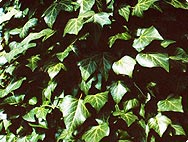A.Vogel search
When the internal search is activated, personal data such as your IP address is transmitted to our search engine Cludo. Data is thus transferred to a third country. Please click here if you want to display the internal search. You can find more information on data protection here: Privacy policy.
A.Vogel plant encyclopaedia
Hedera helix L.
Common Ivy
History

Ivy was in high esteem among many ancient authors. In ancient Egypt, ivy was holy to Osiris, the god of fertility and ruler of the underworld. In Greek and Roman mythology, ivy, along with the grapevine, was an attribute of the wine gods Dyonisus and Baccus. We encounter the ivy motif frequently in early Christian symbolism and in medieval cathedrals.
Hedera, the Latin name for ivy, is found as early as Virgil and Pliny. It is said to derive from the Greek hédra or haerere, which mean to «sit», and which refers to the grasp of its roots. The Greek word helix means «winding» or «spiral-shaped». Botanically, this name is misleading, since ivy has no tendrils and does not entwine around a support. It merely holds fast as a root climber. The derivation of the English name is uncertain. It is obscurely related to the Old High German ebihouui and Middle High German ebah.
The medicinal use of ivy is well documented. Hippocrate's writings already describe the ivy's root, leaves, and berries as medicines for internal and external use.
Botanical characteristics

Ivy is a very robust climbing plant up to 20 m high, whose roots grasp trees, rocks, and walls. It is not a parasite! When ivy-covered trees die, it is due to «strangulation» when the ivy stems lignify, thus limiting the growth of the supporting tree. There are individual plants as much as 500 years old whose trunks are up to 2 meters in diameter. Out of the woody rootstock grow round, branching twigs with dark green, three- to five-lobed leaves. The leathery leaves, glossy on the upper surface and with light-colored veins, are winter hardy.
In the Fall, the upper twigs bear greenish, inconspicuous umbels. In Spring, these ripen into initially green, then blue-black, poisonous berries. Leaves on the flower-bearing twigs have a different form (leaf dimorphism); they are oval to lance-shaped and undivided. Ivy forms flowers only if it grows in a warm, protected location and not until the plant is 8 to 10 years old. It propagates primarily vegetatively. The plant flowers from September to October; seeds form in the following Spring.
Habitat

Ivy loves sparse mixed forests, warm rocks and walls and thrives at altitudes up to 1800 m above sea level. It is native to western, central, and southern Europe as well as southeast Asia. Its climbing nature makes it popular with gardeners as a decorative plant and wall cover. Ivy is the only European representative of the Araliaceae. As such, it is a relative of the Far East's ginseng.
Preparation

A.Vogel/Bioforce uses the alcoholic tincture from fresh, unlignified shoots collected from flowering wild plants. The shoots are gathered in the Fall.
Ivy is seldom prepared as a tea. Rather, ivy leaves are used in homeopathic dilution.